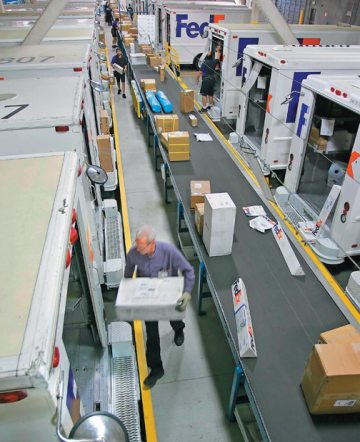
Businesses Large and Small
American.gov | 2013-01-24 14:39

Federal Express, which delivers packages around the world, started out as a small business. (© AP Images/Tony Avelar)
Businesses of different sizes contribute diverse strengths
(The following article is taken from the U.S. Department of State publication, USA Economy in Brief.)
Small businesses, those having fewer than 500 employees, loom large in the U.S. economy. They can respond quickly to changing economic conditions and customer needs with innovative technical solutions to production problems. Their share of nonfarm GDP reached 50.7 percent in 2004.
"Of the nearly 26 million firms in the United States, most are very small – 97.5 percent ... have fewer than 20 employees," the U.S. Small Business Administration says. "Yet cumulatively, these firms account for half of our nonfarm real gross domestic product, and they have generated 60 to 80 percent of the net new jobs over the past decade."
Many entrepreneurs began by tinkering with hand-assembled machines in a home garage. A few expanded small businesses quickly into large, powerful corporations. Some examples: software manufacturer Microsoft, delivery service Federal Express, sports clothing manufacturer Nike, online service provider AOL, and ice cream maker Ben & Jerry's.
Women own and operate many small businesses. In 2002, women-owned businesses accounted for 28 percent of all U.S. companies except for farms, 6 percent of all U.S. workers, and 4 percent of U.S. business receipts.
Persons from minority groups run many small businesses. Of all U.S. nonfarm firms in 2002, 6.8 percent were owned by Hispanic Americans, 5.2 percent by African Americans, 4.8 percent by Asian Americans, 0.9 percent by American Indians or Alaskan Natives, and 0.1 percent by Native Hawaiian or other Pacific Islanders.
Small businesses employ almost exactly half the private U.S. labor force of about 153 million. In 2003 the average small business had one location and 10 employees; the average big business, 61 locations and 3,300 employees.
Many U.S. businesses large and small are organized as publicly traded corporations. Corporations have proved especially effective at accumulating the money needed to pay for launching and expanding operations.

Women-owned businesses account for more than a quarter of all U.S. companies. (© AP Images/Claire Chandler/Alaska Journal of Commerce)
To raise money, corporations sell stock (ownership shares in their assets) or bonds (loans of money) to investors. Commercial banks also lend money directly to businesses large and small. Federal and state governments enforce detailed regulations to ensure the safety and soundness of this financial system and give investors the information they need to make well-informed decisions.
A major corporation may be owned by a million or more people, most of them holding shares worth tiny fractions of the company's total worth. About half of all U.S. households own common stock, directly or through mutual funds or retirement pension investment plans.
"The majority of America's workers are participants in our capital markets," Christopher Cox, Securities and Exchange Commission chairman, said in a 2007 speech. "It is increasingly true – and increasingly apparent – that what's good for American investors is good for the American people."
Because shareholders generally cannot manage a corporation's business themselves, they elect a board of directors to make broad policy. Corporate boards place day-to-day management decisions in the hands of a chief executive officer (CEO).
As long as a CEO has the confidence of the board of directors, he or she generally is given broad freedom in running a corporation. But stockholders, acting in concert, can force a change in management. In an extraordinary display of assertiveness in 2004-2006, boards forced out the chairmen or CEOs of several major corporations for perceived failures in ethical behavior or performance.
Most corporations are small; some are gigantic. In 2006, a year of record oil prices, Exxon Mobil Corporation reported a record annual profit for a U.S. corporation of $39.5 billion – more than $75,000 per minute – on revenue of $347 billion. Wal-Mart stores topped the list for 2006 corporate revenue at $351 billion.
But aren't workers the ones making the U.S. economy productive?
Share this page



















